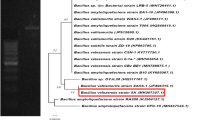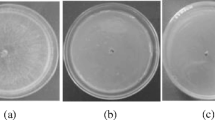Abstract
An endophytic bacterium was isolated from Chinese medicinal plant Scutellaria baicalensis Georgi. The phylogenetic and physiological characzterization indicated that the isolate, strain ES-2, was Bacillus amyloliquefaciens, which produced two families of secondary metabolites with broad-spectrum antibacterial and antifungal activities. Culture filtrate of ES-2 displayed antagonism against some phytopathogenic, food-borne pathogenic and spoilage bacteria and fungi owing to the existence of antimicrobial compounds. A HPLC-MS analysis showed two series of ion peaks from the culture filtrate. A further electrospray ionization/collision-induced dissociation spectrum revealed that the two series ion peaks represented different fengycin homologues and surfactin homologues, respectively, which had a potential for food preservation and the control of several fungal plant diseases.
Similar content being viewed by others
References
Bie XM, Lu ZX, Lu FX, Zeng XX (2005) Screening the main factors affecting extraction of the antimicrobial substance from Bacillus sp. fmbJ using Plackett-Burman method. World J Microbiol Biotechnol 21:925–928
Hiradate S, Yoshida S, Sugie H, Yada H (2002) Mulberry anthracnose antagonists (iturins) produced by Bacillus amyloliquefaciens RC-2. Phytochemistry 61:693–698
Kim PI, Chung KC (2004) Production of antifungal protein for control Colletotrichum lagenarium by Bacillus amyloliquefaciens MET0908. FEMS Microbiol Lett 234:177–183
Kim PI, Bai H, Bai D, Chae H, Chung S, Kim Y, Park R, Chi YT (2004) Purification and characterization of a lipopeptide produced by Bacillus thuringiensis CMB26. J Appl Microbiol 97:942–949S
Koumoutsi A, Chen XH, Henne A, Liesegang H, Hitzeroth G, Franke P,Vater J, Borriss R (2004) Structural and functional characterization of gene clusters directing nonribosomal synthesis of bioactive cyclic lipopeptides in Bacillus amyloliquefaciens strain FZB42. J Bacteriol 186:1084–1096
Kowall M, Vater J, Kluge B, Stein T, Franke P, Ziessow D (1998) Separation and characterization of surfactin isoforms produced by Bacillus subtilis OKB 105. J Colloid Interface Sci 204:1–8
Li BQ, Fu T, Yan YD, Mikovits JA, Ruscetti FW, Wang JM (2000) Flavonoid baicalin inhibits HIV-1 infection at the level of viral entry. Biochem Biophys Res Commun 276:534–538
Ma SC, Du JP, But PH, Deng XL, Zhang YW, Ooi VEC, Xu HXS, Lee HS, Lee SF (2002) Antiviral Chinese medicinal herbs against respiratory syncytial virus. J Ethnopharmacol 79:205–211
Marikawa M, Ito M, Imanaka, T (1992) Isolation of a new surfactin producer Bacillus pumilus A-1, and cloning and nucleotide sequence of the regulator gene, psf-1. J Ferment Bioeng 74:216–255
Perez C, Suarez C, Castro GR (1993) Antimicrobial activity determined in strains of Bacillus circulans cluster. Folia Microbiol 38:25–28
Priest FG, Goodfellow M, Shute LA, Berkeley RCW (1987) Bacillus amyloliquefaciens sp. nov. nom. rev. Int J Syst Bacteriol 37:66–71
Roongawang N, Thaniyavarn J, Thaniyavarn S, Kameyama T, Haruki M, Imanaka T, Morikawa M, Kanaya S (2002) Isolation and characterization of a halotolerant Bacillus subtilis BBK-1 which produces three kinds of lipopeptides: bacillomycin L, plipastatin, and surfactin. Extremophiles 6:499–506
Schulz B, Sucker J, Aust HJ, Krohn K, Ludewig K, Jones PG, Doring D (1995) Biologically active secondary metabolites of endophytic Pezicula species. Mycol Res 99:1007–1015
Schulz B (2001) Endophytic fungi: a source of novel biologically active secondary metabolites, British Mycological Society, International Symposium Proceedings, Bioactive fungal metabolites: impact and exploitation, University of Wales, Swansea
Sneath PHA (1986) Endospore-forming Gram-positive rods and cocci. In: Sneath PHA, (ed) Bergeyȁ9s Manual of Systematic Bacteriology, vol 2. Williams and Wilkins, Baltimore, MD. pp 1104–1138 ISBN 0–683–07893–3
Souto GI, Correa OS, Montecchia MS, Kerber NL, Pucheu NL, Bachur M, García AF (2004) Genetic and functional characterization of a Bacillus sp. Strain excreting surfactin and antifungal metabolites partially identified as iturin-like compounds. J Appl Microbiol 97:1247–1256
Stein T (2005) Bacillus subtilis antibiotics: structure, syntheses and specific functions. Mol Microbiol 56:845–857
Strobel GA (2003) Endophytes as sources of bioactive products. Microbes Infect 5:535–544
Sun LJ, Lu ZX (2005) Advance on antibiotics produced by endophytes. Food Ferment Ind (China) 31:39–41
Vanittanakom N, Loeffler W (1986) Fengycin—a novel antifugal lipopeptide antibiotics produced by Bacillus subtilis F-29–3. J Antibiot (Tokyo) 39:888–901
Vater J, Kablitz B, Wilde C, Frank P, Mehta N, Cameotra SS (2002) Matrix-assisted laser desorption ionization-time of flight mass spectrometry of lipopeptide biosurin whole cells and culture filtrates of Bacillus subtilis C-1 isolated from petroleum sludge. Appl Environ Microbiol 68: 6210–6219
Wang J, Liu J, Wang X, Yao J, Yu Z (2004) Application of electrospray ionization mass spectrometry in rapid typing of fengycin homologues produced by Bacillus subtilis. Lett Appl Microbiol 39:98–102
Wang SL, Shih IL, Liang TW, Wang CH (2002) Purification and characterization of two antifungal chitinases extracellularly produced by Bacillus amyloliquefaciens V656 in a shrimp and crab shell powder medium. J Agric Food Chem 50:2241–2248
Weisburg WG, Barns SM, Pelletier DA, Lane DJ (1991) 16S ribosomal DNA amplification for phylogenetic study. J Bacteriol 173:697–703
Yang X, Strobel GA, Stierle A, Hess WM, Clardy J (1994) A fungal endophyte-tree relationship: Pboma sp. in Taxus wallicbana. Plant Sci 102:1–9
Yoshida S, Hiradate S, Tsulamoto T, Hatakeda K, Shirata A (2001) Antimicrobial activity of culture filtrate of Bacillus amyloliquefaciens RC-2 isolated from mulberry leaves. Phytopathology 91:181–187
Yu GY, Sinclair JB, Hartman GL, Bertagnolli BL (2002) Production of iturin A by Bacillus amyloliquefaciens suppressing Rhizoctonia solani. Soil Biol Biochem 34:955–963
Acknowledgements
The authors would like to thank the financial support from High-Tech fund of Jiangsu Province, PR China (BG2003311) and Key-Subject fund of Anhui Science and Technology University (YZD2004–16).
Author information
Authors and Affiliations
Corresponding author
Rights and permissions
About this article
Cite this article
Sun, L., Lu, Z., Bie, X. et al. Isolation and characterization of a co-producer of fengycins and surfactins, endophytic Bacillus amyloliquefaciens ES-2, from Scutellaria baicalensis Georgi. World J Microbiol Biotechnol 22, 1259–1266 (2006). https://doi.org/10.1007/s11274-006-9170-0
Received:
Accepted:
Published:
Issue Date:
DOI: https://doi.org/10.1007/s11274-006-9170-0




